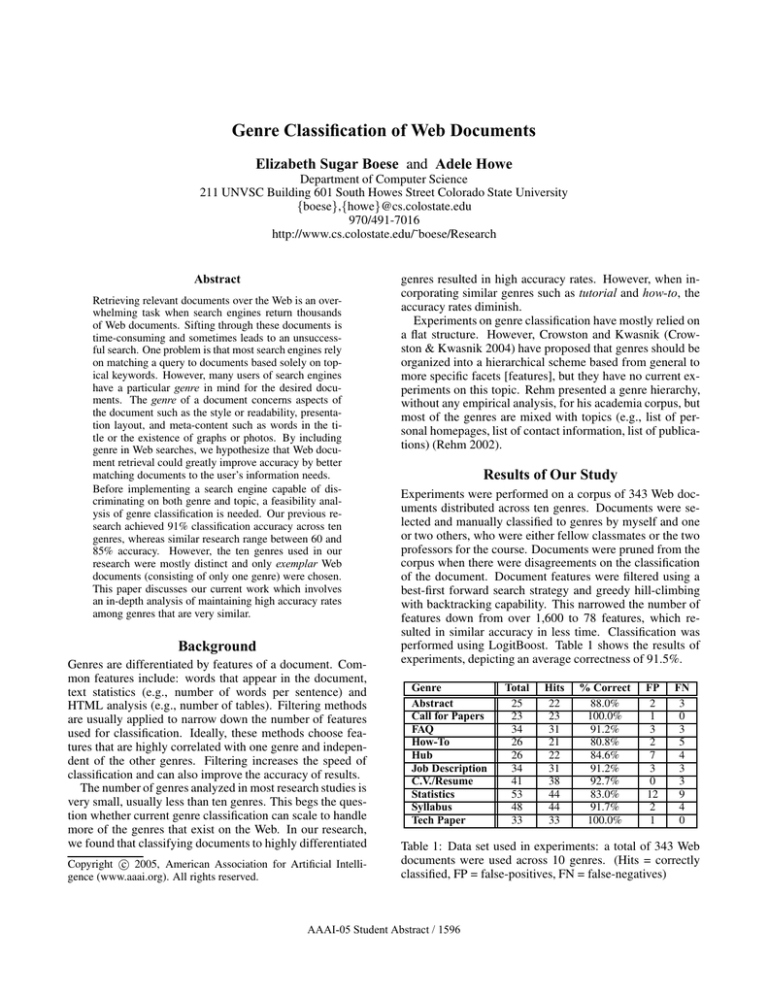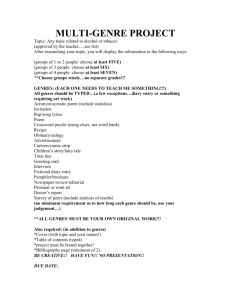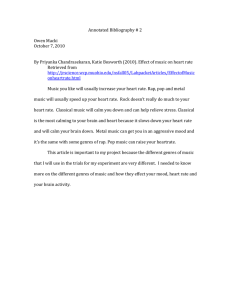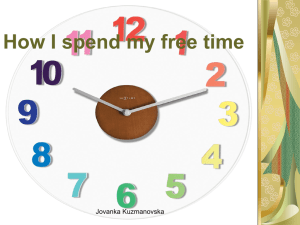Genre Classification of Web Documents Elizabeth Sugar Boese Adele Howe
advertisement

Genre Classification of Web Documents
Elizabeth Sugar Boese and Adele Howe
Department of Computer Science
211 UNVSC Building 601 South Howes Street Colorado State University
{boese},{howe}@cs.colostate.edu
970/491-7016
http://www.cs.colostate.edu/˜boese/Research
Abstract
Retrieving relevant documents over the Web is an overwhelming task when search engines return thousands
of Web documents. Sifting through these documents is
time-consuming and sometimes leads to an unsuccessful search. One problem is that most search engines rely
on matching a query to documents based solely on topical keywords. However, many users of search engines
have a particular genre in mind for the desired documents. The genre of a document concerns aspects of
the document such as the style or readability, presentation layout, and meta-content such as words in the title or the existence of graphs or photos. By including
genre in Web searches, we hypothesize that Web document retrieval could greatly improve accuracy by better
matching documents to the user’s information needs.
Before implementing a search engine capable of discriminating on both genre and topic, a feasibility analysis of genre classification is needed. Our previous research achieved 91% classification accuracy across ten
genres, whereas similar research range between 60 and
85% accuracy. However, the ten genres used in our
research were mostly distinct and only exemplar Web
documents (consisting of only one genre) were chosen.
This paper discusses our current work which involves
an in-depth analysis of maintaining high accuracy rates
among genres that are very similar.
Background
Genres are differentiated by features of a document. Common features include: words that appear in the document,
text statistics (e.g., number of words per sentence) and
HTML analysis (e.g., number of tables). Filtering methods
are usually applied to narrow down the number of features
used for classification. Ideally, these methods choose features that are highly correlated with one genre and independent of the other genres. Filtering increases the speed of
classification and can also improve the accuracy of results.
The number of genres analyzed in most research studies is
very small, usually less than ten genres. This begs the question whether current genre classification can scale to handle
more of the genres that exist on the Web. In our research,
we found that classifying documents to highly differentiated
c 2005, American Association for Artificial IntelliCopyright gence (www.aaai.org). All rights reserved.
genres resulted in high accuracy rates. However, when incorporating similar genres such as tutorial and how-to, the
accuracy rates diminish.
Experiments on genre classification have mostly relied on
a flat structure. However, Crowston and Kwasnik (Crowston & Kwasnik 2004) have proposed that genres should be
organized into a hierarchical scheme based from general to
more specific facets [features], but they have no current experiments on this topic. Rehm presented a genre hierarchy,
without any empirical analysis, for his academia corpus, but
most of the genres are mixed with topics (e.g., list of personal homepages, list of contact information, list of publications) (Rehm 2002).
Results of Our Study
Experiments were performed on a corpus of 343 Web documents distributed across ten genres. Documents were selected and manually classified to genres by myself and one
or two others, who were either fellow classmates or the two
professors for the course. Documents were pruned from the
corpus when there were disagreements on the classification
of the document. Document features were filtered using a
best-first forward search strategy and greedy hill-climbing
with backtracking capability. This narrowed the number of
features down from over 1,600 to 78 features, which resulted in similar accuracy in less time. Classification was
performed using LogitBoost. Table 1 shows the results of
experiments, depicting an average correctness of 91.5%.
Genre
Abstract
Call for Papers
FAQ
How-To
Hub
Job Description
C.V./Resume
Statistics
Syllabus
Tech Paper
Total
25
23
34
26
26
34
41
53
48
33
Hits
22
23
31
21
22
31
38
44
44
33
% Correct
88.0%
100.0%
91.2%
80.8%
84.6%
91.2%
92.7%
83.0%
91.7%
100.0%
FP
2
1
3
2
7
3
0
12
2
1
FN
3
0
3
5
4
3
3
9
4
0
Table 1: Data set used in experiments: a total of 343 Web
documents were used across 10 genres. (Hits = correctly
classified, FP = false-positives, FN = false-negatives)
AAAI-05 Student Abstract / 1596
Although the results are very good, there are some points
that must be noted. First, only exemplar Web documents
were chosen for each genre. A document was considered to
be exemplar if it contained only one genre. This was necessary to avoid the complexity of multi-classification confounding the results. Second, the genres are mostly disparate, which becomes apparent when classifying similar
genres. We performed an experiment combining how-to and
tutorial documents into the same genre and classified across
the ten genres. This resulted in about 63% accuracy, a degradation of 28% from that shown in Table 1. We hypothesize
that combining these two genres led to a multitude of inconsistent features, which led to the degradation of accuracy.
Similar genres can be identified from a confusion matrix.
For our data, Figure 1 shows that six statistics Web documents were mis-classified as hub genre, and four hub documents as statistics. Further analysis of the corpus revealed
that many of the documents classified as statistics contained
a set of links, especially when each data item in the table of
statistics was a link for more information.
a b c d e f g h i j <- classified
21 2 0 0 0 1 0 0 1 0 | a=Abstract
1 22 0 0 0 0 0 0 0 0 | b=Cfp*
0 0 31 3 0 0 0 0 0 0 | c=FAQ
0 1 1 20 0 1 0 2 1 0 | d=How-to
0 0 0 1 22 0 0 3 0 0 | e=Hub
0 0 0 2 0 32 0 0 0 0 | f=Job desc
0 0 0 0 0 0 41 0 0 0 | g=Resume/C.V.
0 0 1 0 3 0 1 47 1 0 | h=Statistics
0 0 0 0 0 0 1 2 45 0 | i=Syllabus
0 0 0 0 0 0 0 0 0 33 | j=Tech paper
22 25 33 26 25 34 43 54 48 33 | Totals
Figure 1: Confusion matrix analyzing the 78 features selected through feature selection. LogitBoost correctly classified 314 out of 343 instances (91.5%) with stratified 10fold cross-validation. *(Cfp = call for papers)
Current Directions
The feasibility of genre classification of Web documents has
been substantiated by many others (Crowston & Kwasnik
2004; Rehm 2002; Rogati & Yang 2002). These studies have
highlighted issues in genre classification. The foremost is
the lack of a standard set of Web genres. Researchers have
postulated any number of Web genres, ranging from seven
to over a hundred. This leads to a lack of pre-classified data
sets to utilize for research experiments. Most researchers
built their own set by surfing the Internet or from search engine results. Although useful for feasibility studies, scaling
the results to practical use requires analyzing more genres
and specifically, similar genres.
Given that we can collect a good corpus, our research is
now directed towards distinguishing similar genres. Preliminary results on how-to and tutorial genres showed that these
genres needed to be separate to achieve high accuracy rates
in classification. We will also address the issue of multigenre documents, such as statistics documents that also resemble the hub genre. We will compare the accuracy rates of
Macro
Form
Help
Homepage
List
Micro (sub-micro)
interactive
non-interactive
faq/q&a
how-to
tutorial
definition
lecture notes / presentation
personal
academic (faculty, student)
corporate
organizational
links/hub/sitemap
downloads
other non-link list (publications, citations,
table of contents, inventory)
statistics
Table 2: Partial hierarchy of Web document genres divided
into three levels: macro, micro, and sub-micro genres. Submicro genres are in parentheses next to the Micro-level.
the different genres, recognizing that some genres (e.g., resumes) will be easier to classify due to the relatively strict
format and other genres (e.g., tutorial) will have a lower
maximum classification accuracy. In addition, we want to
find other genres that may be combined (e.g. homepages :
company, organization, faculty, student and personal).
Our goal is to determine the level of granularity and specificity required for genre classification of Web documents by
creating a hierarchy of genres. A partial hierarchy scheme,
as depicted in Table 2, could integrate into applications such
as search engines and directory structures. A search engine
could organize results in a genre outline. Directory structures such as Yahoo! and Google could use the genre hierarchy as part of the directory structure, so that surfers desiring
a particular genre could more easily access relevant documents. This research leads in to our long-term goal of developing a search engine that integrates genre classification to
improve usability.
References
Crowston, K., and Kwasnik, B. 2004. A framework for
creating a facetted classification for genres: Addressing issues of multidimensionality. In Proceedings of the 37th Annual Hawaii International Conference on System Sciences.
Oahu, HI: IEEE Computer Society.
Rehm, G. 2002. Towards automatic web genre identification. In Proceedings of the Hawaiian International Conference on System Sciences. Oahu, HI: IEEE Computer Press.
Rogati, M., and Yang, Y. 2002. High-peforming feature
selection for text classification. In Proceedings of ACM
Conference on Information and Knowledge Management
(CIKM) ’02. McLean, Virginia: ACM Press.
AAAI-05 Student Abstract / 1597





